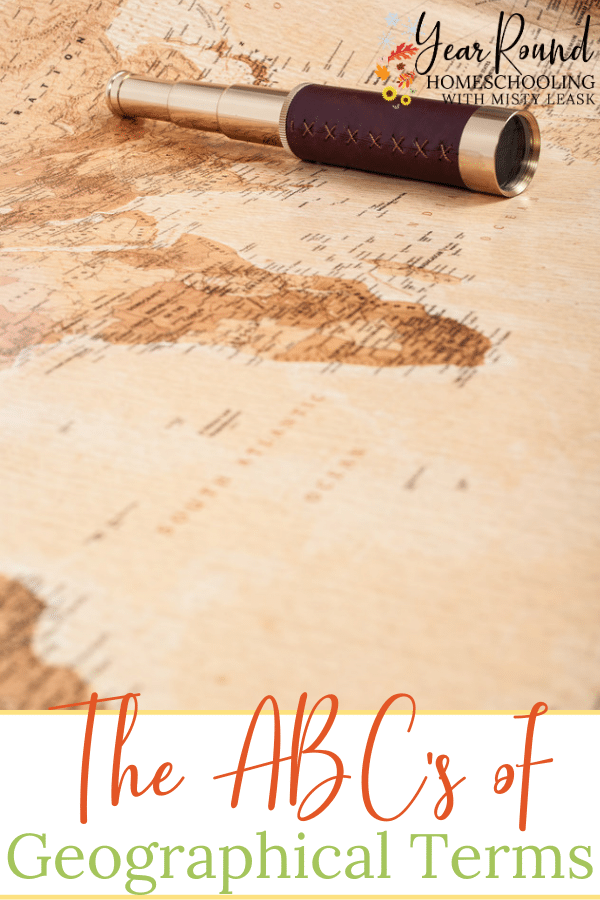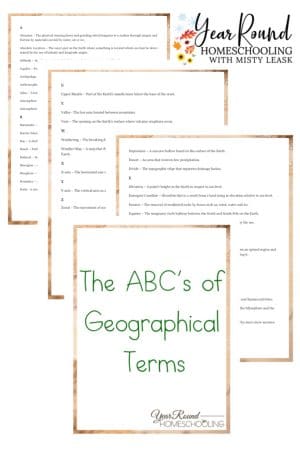Learning about geography can be fun, but there are a lot of terms that your children need to know in order to understand what they are learning. To make this easier for your students, we have put together a list of the most important geographical terms in alphabetical order!

At the end of this list you’ll find that we’ve created a printable for you to download, so that your students can have the information they need on hand throughout their geography course.
A
Abrasion – The physical wearing down and grinding which happens to a surface through impact and friction by materials carried by water, air or ice.
Absolute Location – The exact spot on the Earth where something is located which can best be determined by the use of latitude and longitude angles.
Altitude – An object or points height in correlation to sea or ground level.
Aquifer – Formations of rock that store groundwater.
Archipelago – An island group that have an arc shape.
Asthenosphere – A zone in the mantle of the Earth.
Atlas – A book containing maps or charts.
Atmosphere – The Earth’s or another planet’s envelope of gases surrounding them.
Atmospheric Pressure – The weight of the atmosphere on a surface.
B
Barometer – An instrument that measures atmospheric pressure.
Barrier Island – Islands of sand that are long and narrow often running parallel to the coastline.
Bay – A sheltered body of what located in a crescent-shaped coast of land.
Beach – Pebble or sandy shores found by the high and low water marks especially by the ocean.
Bedrock – Solid rock underlying loose deposits such as soil or alluvium.
Bioregion – An Earth region that is unique due to its distinct soil, climate, animals, etc.
Biosphere – The Earth’s regions and its atmosphere which are occupied by living organisms.
Boundary – A dividing life that marks the limits of a particular area.
Butte – A steep-sided and flat-topped isolated hill.
C
Canyon – A valley with steep sides whose depth is much greater than its width.
Canal – An artificial waterway to allow boats or ships passage inland or for water irrigation purposes.
Cape – The point or extension of a piece of land extending into the water.
Cardinal Points – The four main navigational directions that are found on a compass or map. (North, South, East and West)
Cartography – The field of study for map creation.
Cave – A natural recess that is located horizontally in the Earth’s surface.
Cliff – A rock face that is tall and steep.
Coastline – The separation line between a land surface from a sea or an ocean.
Compass – A navigation instrument that uses the magnetic field of the Earth to determine direction.
Compass Rose – A circle printed on a map or chart showing the principal directions.
Continent – Continuous expanses of land throughout the world.
Continental Crust – The portion of the Earth’s crust that is granitic and makes up the continents.
Continental Divide – An imaginary geographical drainage divide on a continent.
Contour Line – A map line which joins points of equal height above or below sea level.
Core – The interior layer of the Earth.
Crust – The outermost solid shell of a rocky planet.
D
Degree – An angular unit of measure which is used to divide the spherical shape of the Earth for geographical purposes.
Delta – A piece of land that is formed at a river’s mouth where the mainstream divides into many distributaries.
Depression – A concave hollow found on the surface of the Earth.
Desert – An area that receives low precipitation.
Divide – The topographic ridge that separates drainage basins.
E
Elevation – A point’s height on the Earth in respect to sea level.
Emergent Coastline – Shoreline that is a result from a land rising in elevation relative to sea level.
Erosion – The removal of weathered rocks by forces such as; wind, water and ice.
Equator – The imaginary circle halfway between the North and South Pole on the Earth.
Estuary – A river’s broad and lower course affected by tides and disrupted by the sea.
Exosphere – The Earth’s atmosphere’s outermost zone.
F
Fall Line – The narrow geographical boundary zone which is marked between an upland region and a plain, noted by the occurrence of falls and rapids rivers and streams crossing it.
Fault – A long break in a rock.
Fissure – A crack or opening in the crust of the Earth.
Fjord – A long, narrow, deep inlet of the sea located between cliffs.
G
Geography – The study of the physical features of the Earth, its atmosphere and human activities.
Geosphere – The Earth’s nonliving parts; the hydrosphere, the cryosphere, the lithosphere and the atmosphere.
Glacier – A thick mass of ice which is the result of compacting snow formed by more snow accumulating than melting within a year.
Globe – A map of the Earth that is true-to-scale and round in shape.
Grid – The lines on a map or chart that represent longitude and latitude.
Gulf – A large body of water that is within a curved coastline.
H
Habitat – The place where an animal or plant lives.
Heterosphere – The upper layer of the atmosphere.
Hemisphere – One half of the Earth.
Homosphere – The lower layer of the atmosphere.
Hydrosphere – The oceans, lakes, rivers and streams which cover the surface of the Earth.
I
Infiltration – The movement and absorption of water downward into the soil.
Ionosphere – The region in the atmosphere above 50 kilometers from the surface.
Island – A piece of land that is surrounded by water.
J
Joint – A rock’s fracture where no movement has taken place.
K
Kettle Hole – A depression found in glacial deposits.
L
Lagoon – Seawater that is nearly cut off from the ocean by a barrier beach.
Lake – A standing body of water located on the Earth’s land masses.
Latitude – The measurement used to determine the distance north or south of the equator.
Legend – The key to the pictures or symbols used on a map.
Lithosphere – The hard outer crust shell of the Earth.
Location – An exact position on the Earth.
Longitude – The measurement used to determine the distance east or west of the prime meridian.
Lower Mantle – The layer of the Earth’s interior from 670-2,900 kilometers below the surface crust.
M
Mantle – The zone found between the crust and core of the Earth’s interior.
Map – A picture of a place often drawn to scale on a flat surface.
Meridian – The circular arc that connects all places of the same longitude at the poles.
Mesa – A hill that is isolated and flat-topped with steep sides.
Mesosphere – An atmospheric layer located between the stratosphere and the thermosphere.
N
North Magnetic Pole – Where the lines of force from Earth’s magnetic field are vertical; located in the Northern Hemisphere.
North Pole – Defined by the intersection of the polar axis with the Earth’s surface whose location is in the Northern Hemisphere at 90 degrees North.
O
Ocean – Large bodies of salt water dividing land masses.
P
Permafrost – A layer of soil that is frozen permanently.
Physical Weathering – The breakdown of rock and minerals from mechanical stress.
Prime Meridian – The reference point for longitude which is an imaginary line running through Greenwich, England from north to south.
Q
R
Region – A territory that has characteristics which distinguish it from other places.
River – A channel of water that is long and narrow that flows across the Earth’s surface by the functions of gravity and elevation.
S
Scale – The system of marks set at fixed intervals on a map which is used to indicate the proportion between the linear measurement and the actual distance on the Earth.
Sea – Part of an ocean that is found on or near a continent on the Earth.
Sea Level – The level of the surface of the ocean.
Shore – Land bordering a large body of water.
South Magnetic Pole – Where the lines of force from Earth’s magnetic field are vertical; located in the Southern Hemisphere.
South Pole – Defined by the intersection of the polar axis with the Earth’s surface whose location is in the Southern Hemisphere at 90 degrees South.
Stratopause – A thin atmospheric layer located between the stratosphere and the mesosphere.
Stratosphere – The stratosphere is an atmospheric layer which contains the ozone layer.
T
Tectonic Plate – A layer of the lithosphere that is extensive and moves across the surface of the Earth’s asthenosphere.
Territory – A specific portion of the surface of the Earth.
Topographic Map – A two dimensional map that uses contour lines to represent a three-dimensional landscape.
Topography – A place’s physical features.
Tropic of Cancer – The imaginary northern boundary line of the tropics.
Tropic of Capricorn – The imaginary southern boundary line of the tropics.
Tundra – An arctic or subarctic treeless plain region.
U
Upper Mantle – Part of the Earth’s mantle layer below the base of the crust.
V
Valley – The low area located between mountains.
Vent – The opening on the Earth’s surface where volcanic eruptions occur.
W
Weathering – The breaking down of rocks which over time become soil.
Weather Map – A map that displays the physical state of the atmosphere and its circulation over the Earth.
X
X-axis – The horizontal axis on a graph.
Y
Y-axis – The vertical axis on a graph.
Z
Zonal – The movement of ocean waters or wind in a direction parallel to latitude lines.
How do you make learning geography fun and easy in your homeschool?

